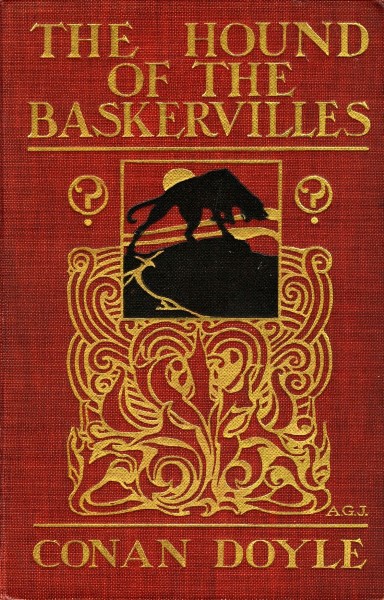
The Hound of the Baskervilles by Sir Arthur Conan Doyle (1901)
Sherlock Holmes and Dr. John Watson are asked by Dr. Mortimer to help protect Sir Henry Baskerville from an undefinable danger. Sir Charles, the uncle of the man who needs protection, had died suddenly at the remote family estate under mysterious circumstances. Rumors are spreading that the ancient Curse of the Baskervilles has returned. The new heir is the last of an old noble family and Dr. Mortimer fears that the Curse — a demonic hound — will claim its next victim. Threats, cryptic warnings, peculiar neighbors, secretive servants, an escaped mental patient, strange lights in the middle of the night, and eerie howls echoing across the countryside all mix to create a classic Gothic mystery and arguably the most beloved stories of one of the most popular fictional characters of all time.
In 1887, Arthur Conan Doyle introduced Holmes and Watson to the world in A Study in Scarlet. By 1893, the author grew to hate the character as he was getting in the way of more serious literary work and killed him off at a waterfall in Switzerland. Written years later in 1901, The Hound of the Baskervilles is set before Holmes’ death and was intended to be a one-off story. Doyle insisted that this was in no way a resurrection. According to the author, the plot was based on a real-life ghost story a friend told him. This legend inspired a timeless tale that has remained popular for over a hundred and twenty years, launching Holmes and Watson into cultural immortality.
Like almost every Sherlock Holmes story, The Hound of the Baskervilles is written from Watson’s perspective. He acts as a stand-in for the reader. We see events unfold in real time as Watson sees them and react when he reacts. Because of this, there are questions that can never be answered because Watson can’t read minds or was not present when certain events occurred. Doyle is aware of this and acknowledges and includes these unknowns into the plot, especially about an important character whose story is never truly concluded. This acceptance of certain limitations also serves to solve a major plot-hole. Doyle wrote himself into a corner concerning the overall conspiracy but resolved it with a quick and definitive I-don’t-know from Holmes. Doyle is so aware of his problem that he has Watson point it out. I cannot explain any further without spoiling the end, but for me, it makes the story more realistic and immersive and makes me respect Doyle as a writer even more.
Although this is billed as a Sherlock Holmes mystery, this is really Watson’s adventure. Holmes is physically present in less than half the book — at the very beginning to get the plot going and the very end to trigger the climax. That’s it. Watson doesn’t get too many stories like this so it’s interesting to see him take center stage. Holmes is not a minor character in any way, however. His reputation and celebrity are ever-present. Every time someone meets Watson, they ask about Holmes: “When is he coming? Will he be coming?” Characters behave according to the mere possibility that Holmes may be involved.
I like how the Hound is used. He reminds me of the shark in the movie Jaws. The shark is almost never seen but is everywhere, nonetheless. It’s similar here. The Hound saturates conversations and dictates movements and actions. He doesn’t have to be seen to impact the plot. His legend — like Holmes’ — is enough. Doyle builds up the Hound in the mind of the reader then waits as long as possible to reveal him. Doyle is purposeful and patient, waiting for maximum dramatic impact. It’s masterful storytelling.
However, the book’s real star is the setting: the craggy, foggy, dreary landscape of Dartmoor, England. In the middle of it, stretching for acres is the fictional Great Grimpen Mire, a quicksand-like bog. Anything that goes in does not come out. This story would not work in any other location. Many times, Watson describes how the features of the Mire affect the mood and personality of the people living there. The landscape is saturated with an inexpressible gloominess and Watson spends a lot of time describing it and how it makes him feel. For Watson, dank, foggy, crowded London is more welcoming than here. Its rocky outcroppings and grim flatlands provide a superb backdrop where, as the legend of the Hound puts it, “the powers of evil are exalted”.
The Hound of the Baskervilles is an excellent story. It is not my favorite original Sherlock Holmes novel — that honor goes to The Sign of Four — but it is, in my opinion, the best. Doyle’s authorship is at its peak here. The book is carefully planned and well-written. The pacing is excellent. Each secondary character is diverse and interesting, and used well. No person or event is superfluous or wasted. Most importantly, the villain is top-notch—intelligent, imaginative, daring, ruthless, and patient. Professor Moriarty is usually seen as Holmes’ greatest enemy, but this guy needs to be in the same conversation. The Hound of the Baskervilles deserves its reputation and is an absolute classic of the genre.
I have adored Sherlock Holmes almost my entire life but have not read the original stories in decades. No reason. Just because. I was excited and nervous to read it again. How many things from our childhood have we revisited as adults only to have them be disappointing? In rereading this book, I was suddenly twelve years old again and smiled the whole time. The Hound of the Baskervilles was exactly as I remembered it.
© April 13, 2024